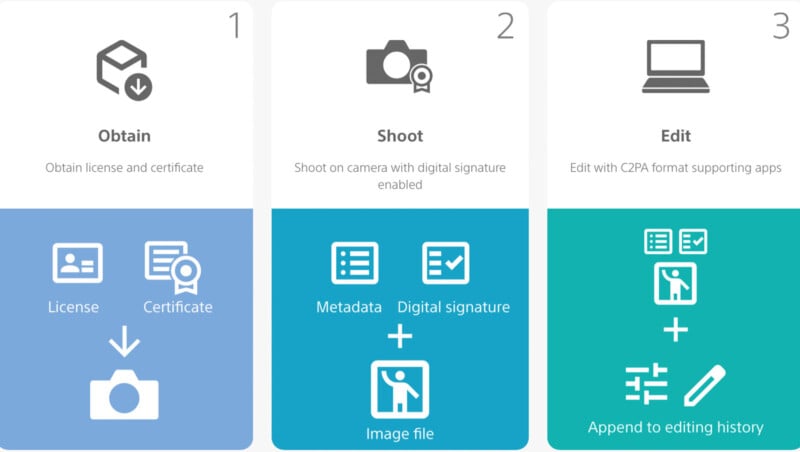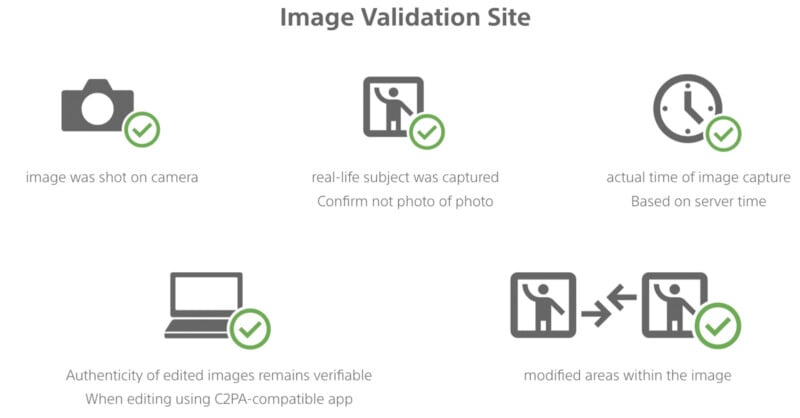![]()
Sony’s comprehensive in-camera authentication technology has been a long time coming, but it has finally arrived for three of Sony’s flagship cameras, the Sony a1, a1 II, and a9 III.
Sony’s Camera Authenticity Solution (CAS) promises to offer photographers a means of verifying the authenticity of their images, providing the confidence that news organizations and people increasingly demand in the age of generative AI.
A member of the Content Authenticity Initiative (CAI), Sony’s authenticity solution relies upon the Coalition for Content Provenance and Authenticity (C2PA) standard. Sony’s approach depends upon hardware and software at the time of capture. The authentication technology verifies that an image was, in fact, shot by a camera thanks to a digital situation created in-camera at the moment the shutter is clicked. This signature is embedded into the captured image in real-time, and the digital keys associated with the pictures are stored in the camera’s chipset.
![]()
However, Sony’s solution goes further, as just because a camera captured an image doesn’t necessarily mean the photograph is of an actual, real event that the photographer shot in person. In addition to the digital signature, the image metadata includes 3D depth of information, which Sony says makes it “possible to verify the authenticity of images with a high degree of accuracy.”
![]()
“By using cameras from Sony, both the image and the 3D depth information can be captured on the sensor along the single light axis, providing information of high authenticity,” Sony adds.
Further, the time and date of image capture can be verified via a secure server-acquired time attached to the image. According to Sony, this is “tamper-proof,” and cannot be changed by anyone.
 For photojournalists, they can use Sony’s new authenticity solution to obtain certificates, enable digital signatures, and work within a C2PA-compliant workflow.
For photojournalists, they can use Sony’s new authenticity solution to obtain certificates, enable digital signatures, and work within a C2PA-compliant workflow.The digital signature, including 3D metadata, can be preserved throughout the capture and editing workflow, provided photographers use C2PA-compatible apps like Adobe software. Provided that the digital signature embedded in the camera stays intact, the authenticity of an image can be verified from capture to publication.
“As a member of the C2PA Steering Committee, Sony plays a leading role in developing these standards and driving their broader implementation,” Sony explains.
It is worth taking a beat here to note the objective of the C2PA format. It is not a solution to say, “This image is not fake.” Instead, it is a means of confirming that an image is authentic. Sony’s CAS aims to deliver the trusted, verifiable ground truth required to know when an image is real. Effective image authenticity starts from a position of truth, rather than a fruitless attempt to prove when something is fake.
 Sony has also launched an image validation site, which news organizations can use to check if an image was shot on a camera, when it was captured, whether it shows a real-life subject, view the editing history, and compare the image against the ground truth photo.
Sony has also launched an image validation site, which news organizations can use to check if an image was shot on a camera, when it was captured, whether it shows a real-life subject, view the editing history, and compare the image against the ground truth photo.As of now, Sony’s Content Authenticity Solution is only available for select news organizations and their staff photographers. Alongside the necessary firmware for the a1, a1 II, and a9 III — more on that below — Sony has also launched an Image Validation Site and Digital Signature Upgrade License.
New Sony Firmware
Beyond adding CAS compatibility, the new firmware updates for the a1 (version 3.00), a1 II (version 2.00), and a9 III (3.00) introduce other new features and improvements. While the complete breakdown is presented in the table below, some highlights are worth discussing.
![]()
The super-fast Sony a9 III can now shoot at shutter speeds up to 1/80,000s at all aperture values, provided that users enable “Exp. Value Expand” in the camera’s menus. Previously, the max shutter speed was limited to 1/16,000s when using an aperture brighter than f/1.8.
Further, the Sony a1 II and a9 III promise improved image quality when applying User LUTs.
![]()
While the a1 II launched late last year with a wide range of usability and workflow improvements, the new firmware improves operability for the original a1 and the a9 III, including software update alerts, FTP transfer scheduling, and better operability when using the Sony Creators’ App.
The new firmware updates are available to download via the following links: Sony a1, Sony a1 II, and Sony a9 III.
Image credits: Sony






 English (US) ·
English (US) ·